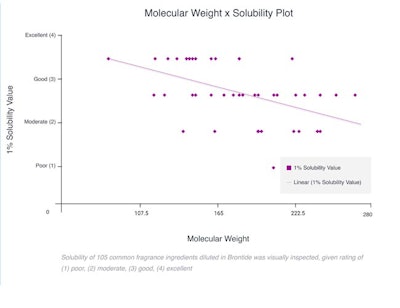
Study in Brief
Genomaticaa engaged MOCA Fragrancesb to conduct a study of over 100 common fragrance ingredients and four diluents to test compatibility and conduct organoleptic blotter evaluations. Each ingredient and diluent were evaluated at multiple dilutions, testing for solubility and comparable odor performance during wet and dry-down periods. This generated more than 1,200 data points to derive conclusions.
Introduction
Demand for sustainable personal care products is on the rise. A 2020 consumer surveyc by Genomatica found that more than a third (37%) of Americans are willing to pay more for sustainable products, even during an economic downturn. While sustainable soaps, lotions and shampoos are increasingly available, the industry continues to search for new, sustainable ingredients for perfumes and fragrances. One leading candidate is Brontided natural butylene glycol. The ingredient is created through the fermentation of plant sugars rather than the conventional petrochemical process—which begins with acetaldehyde, a mutagen and carcinogen.
Butylene glycol, a colorless organic alcohol, is commonly used in a wide range of personal care products as a solvent with antimicrobial properties and as a humectant. Additionally, it’s used to evenly disperse plant extracts, flavors and fragrances. A multifunctional ingredient, butylene glycol is a central component in various personal care products and cosmetics on the shelves today, including serums, body scrubs, masks, cleansers and more.
To further explore the benefits of Brontide natural butylene glycol in fragrances, Genomatica recently engaged MOCA Fragrances to conduct a study of over 100 common fragrance ingredients and four different types of diluents. The study included solubility testing and an organoleptic blotter evaluation, previewing the exciting potential of this ingredient for enhancing fragrance profiles while reducing greenhouse gas emissions.
What are Fragrance Diluents?
When we think of perfumes and fragrances, we think of their distinct and often captivating scents. But on average, 20-40% of the liquid in a fragrance formulation is actually a diluent, the delivery system for scents. With this knowledge, we can think of diluents as the “canvas” that scents are “painted on.” A good diluent serves as an imperceptible background to the art of a fragrance. In the lab, diluents are used as a metering tool to increase or decrease the strength of an odor in the fragrance, providing precise control and clarity of the olfactory notes.
A Qualitative and Quantitative Analysis of Fragrance
In Genomatica’s recent study, MOCA Fragrances compared Brontide natural butylene glycol to three common diluents: dipropylene glycol (as the industry benchmark) as well as benzyl benzoate and isopropyl myristate (common natural diluents). The respective solubility and organoleptic rating across multiple fragrance ingredient dilutions were evaluated as part of the study. The results showcased Brontide natural butylene glycol’s high-performance traits in fragrances, revealing benefits above and beyond its attractiveness as a sustainable ingredient in personal care and cosmetics applications.
As a next step, MOCA Fragrances explored how Brontide natural butylene glycol interacts with a number of common fragrance ingredients at various dilutions. Results showed that the ingredient was successful in enhancing the scent of fragrance ingredients, producing a final product uninhibited by the Brontide natural butylene glycol. This was a key discovery, as some diluents can suppress the fragrance components, thus requiring more of an ingredient to achieve the desired effect. Achieving a desired level of fragrance with less of a source ingredient can reduce overall formulation costs.
Brontide natural butylene glycol was evaluated alongside three commonly used diluents in the fragrance industry: dipropylene glycol (DPG), isopropyl myristate (IPM) and benzyl benzoate (BB). Dilutions 100+ natural and synthetic ingredients across the odor spectrum were compounded at dilutions ranging from 10% to 1%, with relative results obtained by blotter evaluation. Statistical regression analysis of the ingredients’ physical properties and observed solubility showed that logP and molecular weight of the ingredients were strong predictors of solubility in Brontide natural butylene glycol. In single ingredient solutions, Brontide natural butylene glycol showed less consistent solubility with less polar (higher logP) ingredients and more consistent solubility with polar (lower logP) ingredients.

 Organoleptic testing was used to assess the strength of fragrance expression in different diluents. Brontide natural butylene glycol consistently outperformed the natural diluents (IPM and BB) and was comparable to DPG in fragrance expression for ingredients with moderate solubility. For ingredients exhibiting excellent solubility when used in Brontide natural butylene glycol, the organoleptic rating was higher than all other diluents tested, including the industry standard, DPG. According to MOCA Fragrances, this finding demonstrates one of Brontide natural butylene glycol’s greatest strengths in fragrance applications—the balancing and expression of different fragrance notes with clear and definitive character.
Organoleptic testing was used to assess the strength of fragrance expression in different diluents. Brontide natural butylene glycol consistently outperformed the natural diluents (IPM and BB) and was comparable to DPG in fragrance expression for ingredients with moderate solubility. For ingredients exhibiting excellent solubility when used in Brontide natural butylene glycol, the organoleptic rating was higher than all other diluents tested, including the industry standard, DPG. According to MOCA Fragrances, this finding demonstrates one of Brontide natural butylene glycol’s greatest strengths in fragrance applications—the balancing and expression of different fragrance notes with clear and definitive character.“The goal is to achieve beautiful and meaningful fragrances that represent life experiences,” said Chris Diienno, master perfumer at MOCA Fragrances. “Managing and expressing these notes and accords with the most clarity gives the perfumer an advantage when conceptualizing the formulation in real-time. That’s where Brontide natural butylene glycol comes in, providing a clear and unobstructed characteristic note of the ingredient it’s diluting.”
A Sustainable Advantage
In 2020, major players in the fragrance industry, including Firmenich, International Flavors and Fragrances (IFF) and Symrise committed to materially shift to more sustainable operations. This is a growing trend happening across many industries today, including key markets like personal care and home care where fragrances are commonly used.
Conforming to the ISO 16128 definition of a natural ingredient, Brontide natural butylene glycol creates a path to achieving key corporate sustainability goals. According to Genomatica’s independent comprehensive life cycle assessment (LCA), Brontide natural butylene glycol can slash global greenhouse gas emissions by about 51% compared to conventional petrochemical production.
Genomatica’s Brontide natural butylene glycol reduces global greenhouse gases by 1.92 kg CO2 per kilogram used compared to conventional production. This could translate to an annual reduction of global greenhouse gases by nearly 100,000 tons of carbon dioxide equivalent (CO2e). Importantly, the results of this study show that perfumers now have the ability to answer consumer demand for more sustainable products without sacrificing the quality and artistry of their fragrances.
Key Takeaways
Many industries, including personal care and cosmetics, are increasingly turning to sustainable practices with consumer support. Brontide natural butylene glycol offers a critical contribution to the fragrance industry as a natural and sustainable alternative to petrochemical-derived diluents. Beyond these properties, the ingredient also has strong preservative-boosting performance, excellent organoleptic ratings and a pleasant, non-greasy skin feel. The data generated indicates a predictable outcome in fragrance formulations while maximizing the value of costly ingredients. All of these traits make Brontide natural butylene glycol an attractive option for formulating sustainable fragrances that provide a clearer and more uninhibited reveal of ingredient fragrance notes.
 awww.genomatica.com
awww.genomatica.combwww.mocafragrances.com
cwww.genomatica.com/survey-sustainability-embraced-despite-pandemic
dwww.brontidebg.com Brontide is a registered trademark of Genomatica










